Savor our list of eco-conscious chefs, then dish on your own favorites in the comments section at the bottom of the page.

Alice Waters, Chez Panisse, Berkeley, Calif., U.S.
Thirty years ago, the words “imported from France” signified the height of status and taste on U.S. restaurant menus. Today, the phrases “locally grown” and “organic” have taken over that function (naming the actual farm earns extra points). For that transformation, we largely have Berkeley restaurateur Alice Waters to thank. Founded in 1971 by Waters and a hedonistic band of hippie-bohemians, Chez Panisse quickly established itself as a temple to European farmhouse-style cooking: simple techniques applied to spectacularly fresh and lovingly grown ingredients. But Waters has done much more than inspire high-end chefs nationwide to become “foragers” of the best things growing in their “foodsheds” — or provide incomparable food for those who can afford the restaurant’s $85 prix fixe menu. By challenging the dreadful U.S. school-lunch system, she has also worked hard to make healthy, sustainably grown food a reality for all citizens of the Fast Food Nation. Her innovative Edible Schoolyard program in a Berkeley middle school has emerged as a model worldwide for how healthy, organically grown food can be a tool to enrich kids’ minds even as it nourishes their bodies.
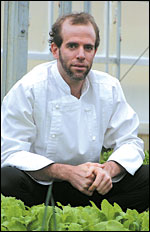
Dan Barber, Blue Hill at Stone Barns, Pocantico Hills, N.Y., U.S.
Of all the U.S. chefs rushing down — and extending — the path blazed by Alice Waters, Dan Barber may be the most important. When he opened Blue Hill Restaurant in Manhattan’s Greenwich Village in 2000, he quickly became as famous for his fanatically sourced ingredients as for his inventive cooking. He hauled in much of his restaurant’s produce from his family’s farm in the Berkshire region of western Massachusetts, and bought the rest at Union Square Greenmarket, where the curly-haired chef became a fixture. In 2004, he began living the dream of every chef who sees cooking as an expression of the surrounding countryside: he opened a restaurant in the middle of a diversified organic farm. Located 30 miles up the Hudson River from New York City, Blue Hill at Stone Barns is the centerpiece of the Stone Barns Center for Food and Agriculture, an 80-acre educational farm situated on an old estate owned by the Rockefeller family. Barber transforms the pristine produce of that farm into some of the nation’s most celebrated cuisine. And like Alice Waters, Barber isn’t content to merely cook glorious food for the well-heeled. He’s also a leading voice in the effort to reform U.S. farm policy, which, he argues, is currently rigged in favor of environmentally destructive industrial agriculture.

Alain Passard, L’Arpège, Paris, France
For years, Alain Passard had been classed among the world’s greatest chefs. His Paris restaurant, L’Arpège, had held a coveted three-star rating from Michelin since 1996, and he had won global fame for his celebrated run in Japan’s Iron Chef competition. But in 2001, Passard shocked the culinary world by abruptly pulling meat from his menu. “I was struggling to have a creative relationship with a corpse, a dead animal!” he would later explain. While his ban on animal flesh isn’t total — he still uses some fish and poultry — he has shifted his creative energies fully to vegetables. As he moves deeper into what he calls a new cuisine vegetale, Passard has turned to growing his own vegetables on his permaculture garden 120 miles southwest of Paris. He hauls the pristine produce into Paris daily by high-speed train. And the European culinary establishment, which initially recoiled from Passard’s new direction, has returned in force. L’Arpège has held on to its third Michelin star — and reservations are as hard as ever to come by.

Fergus Henderson, St. John Restaurant, London, U.K.
If Passard startled the culinary world by renouncing meat, London chef Fergus Henderson turned it on its head by embracing animal flesh in its entirety. His logic goes like this: If you’re going to eat animals, it’s wasteful to focus simply on the center cuts: chops, steaks, breasts. Instead, meat eaters must embrace the “whole beast” — the title of his celebrated cookbook — including what’s known as the nasty bits: heart, tongue, spleen, etc. In the 1990s, when London chefs were rescuing their city’s culinary reputation by looking to southern Europe for inspiration, Henderson was doing stripped-down, sublime versions of homely British classics, leaning heavily on offal — always from humanely raised and slaughtered animals. His “nose-to-tail” ethic has sparked a trend in the United States. Not only are many chefs insisting on using only locally raised, pastured meat, but they’re also educating their clientele on what Henderson has called the “set of delights, textural and flavorsome, that lie beyond the fillet.”

Chris Cosentino, Incanto, San Francisco, Calif., U.S.
In a sense, Cosentino can be thought of as the love child of Alice Waters and Fergus Henderson. Cosentino runs Incanto’s kitchen as a showcase for the wares of Northern California’s farmers, as you would expect from someone who counts Chez Panisse on his resume. And he’s also probably the No. 1 U.S. proponent of “nose-to-tail” eating — he’s so committed to the idea that he writes a blog called Offal Good. (A recent post offered a recipe for duck testicles — a dish which, Cosentino boasts, “a growing number of guests are ordering … and really enjoying.”) Incanto also sparked a trend among Bay Area restaurants to stop selling highly profitable but energy-sucking bottled water. Incanto now offers house-purified still and sparkling water to guests at no charge.
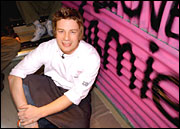
Jamie Oliver, Fifteen, London, U.K.
Jamie Oliver, television’s “Naked Chef,” can cut a frivolous figure, with his boyish looks and slangy style. Yet he may be the world’s most effective chef-activist. For years, he has used his considerable celebrity to harangue the British government to improve its school-lunch program, which for decades has relied heavily on cheap processed food. In 2005, he used a reality TV show set in a Dickensian public-school cafeteria to shame the government into boosting the amount spent on school lunches by more than $500 million per year. And he’s not done. Just last year, Oliver issued a manifesto [PDF] declaring that the government’s efforts at improving lunches still fall well short — and giving specific policy recommendations for improvement. In addition to demanding healthy meals prepared from scratch for all students, Oliver also wants schools to buy direct from local, preferably organic, farmers.

Andrea Reusing, Lantern, Chapel Hill, N.C., U.S.
Operating far from the New York/San Francisco media glare, Andrea Reusing has quietly made herself into a model for the citizen-chef. In her off hours, she works tirelessly to promote the produce of central North Carolina’s bustling sustainable-agriculture scene. She chairs Slow Food Triangle’s convivium, which essentially exists to promote the area’s small organic farms. And finally, in the kitchen of Lantern, Reusing takes the best of what her farmer friends grow and transforms it into extraordinary and rigorous Pan-Asian food — which has put Lantern and the farmers who supply it on the national culinary map.

Corrado Assenza, Caffé Sicilia, Noto, Sicily, Italy
In a listing of the globe’s greenest chefs, it may seem odd to include a man who toils at what is essentially a Sicilian espresso bar. Yet Caffé Sicilia, situated in the beautifully preserved baroque town of Noto, is no ordinary espresso bar. Wander there for an afternoon shot, and prepare to be dazzled by the wares of Corrado Assenza, a fourth-generation café owner whom many consider Italy’s greatest pastry chef. But Assenza’s wizardry with gelato, panna cotta, and other delights of the Italian dessert table aren’t what put him on this list. Rather, it’s his insistence on using the best ingredients he can find from nearby farms. Sicily boasts some of Italy’s most productive farmland, but its best produce is often shipped throughout Europe, increasingly leaving its citizens to get by on processed food. Assenza is at the forefront of a movement to reclaim Sicily’s culinary produce for its citizens — and promote organic agriculture in the process.
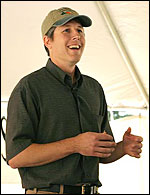
Tod Murphy, Farmers Diner, Quechee, Vt., U.S.
At an unassuming diner in small-town Vermont, Tod Murphy is running what might be the greenest restaurant in the United States. The idea is elegant and deceptively simple: take products from nearby farms, use them to create straightforward diner dishes like burgers and milkshakes, and sell them at a price accessible to most of the community’s residents — including its farmers. While buying direct from nearby farmers is certainly more expensive than tapping global distribution chains, Murphy hopes to make a small profit by achieving high volume — the opposite of Chez Panisse’s boutique approach. Murphy figures that for the local-food trend to truly deliver on its environmental and social promises, it will have to be broadly accessible. “Local good food shouldn’t just be a rich person’s item … It should be for everybody,” he recently told The Boston Globe. And Farmers Diner has emerged as a closely watched experiment on whether that ideal can become reality.

Ted Walter, Passion Fish, Pacific Grove, Calif., U.S.
Perhaps no issue links food and environment quite like the state of the oceans. Relentlessly growing human demand for fish is placing severe strains on aquatic ecosystems. If present fishing trends continue, the journal Science warns, marine life faces widespread collapse by 2048. Ted Walter, chef-owner of Passion Fish, stands at the forefront of a growing movement by restaurateurs to educate the public about sustainable seafood. Echoing the Worldwatch Institute, Walter argues that smart harvesting can actually strengthen global fish stocks. And in a bold move for a restaurant renowned for its seafood, Passion Fish recently announced it will only serve fish not in danger of extinction. Given that restaurants account for 70 percent of fish consumed in the U.S., it would make a big impact if Walter’s stance started a trend.
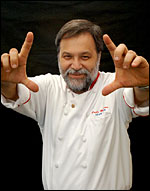
Paulo Martins, Lá em Casa, Belém, Brazil
Despite years of support from do-gooding celebrities, Brazil’s Amazon rainforest still needs all the help it can get. Demand for European and U.S. biofuel is surging, giving farmers incentive to rip into the Amazon to plant soybeans for biodiesel production. One way to save the rainforest from the plow — to convince the world of its value — is to sustainably harvest the fruits of its vast biodiversity. That’s the strategy of Paulo Martins, who has been using exotic produce to create a global stir at his restaurant, Lá em Casa, in the heart of the rainforest. Martins leans heavily on the region’s 1,500 species of freshwater fish and 1,000 species of fruit to create a cuisine that’s igniting the imaginations of chefs from São Paulo to Barcelona. Martins openly acknowledges his debt to indigenous cooking styles that dominated in the region until colonization in the 16th century — and still flourish in pockets today. By flaunting the culinary delights of his region’s flora and fauna, Martins hopes to drive home the point that the Amazon region — perhaps the world’s greatest natural carbon sink — has far more important reasons for existence than serving as a mere source of fuel for European and U.S. cars.
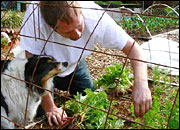
David Kinch, Manresa, Los Gatos, Calif., U.S.
Sourcing seasonal, organic vegetables from nearby farms has become standard in Northern California. David Kinch of Manresa, located in Silicon Valley, is taking the revolution started by Alice Waters one step further. He’s collaborating directly with Love Apple Farm in the nearby Santa Cruz Mountains to custom-grow vegetables. Going beyond organic, Kinch and his farmer-collaborator Cynthia Sandberg grow heirloom tomatoes and other delights with biodynamic techniques. In the process, he’s turning Manresa into one of the world’s most celebrated restaurants.

Ferran Adrià, El Bulli, Roses, Spain
A leading proponent of the “molecular gastronomy” movement, Ferran Adrià probably ranks as the globe’s greatest chef, based on his wildly innovative cuisine. But peel away the mad-genius exterior, and you’ll find a cook deeply devoted to his surrounding foodscape — Spain’s Costa Brava. In his cooking manifesto, Adrià declares that “preference is given to vegetables and seafood … in recent years, red meat and large cuts of poultry have been very sparingly used.” And the care with which he chooses the fruits of local farmers and fishers has become legendary. Along with Allain Passard and other European chefs, Adrià launched Vive las Verduras (Long Live Vegetables) in 2007, a group devoted to wedding haute cuisine with sustainable vegetable farming.
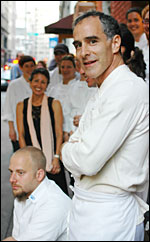
Peter Hoffman, Savoy, New York, N.Y., U.S.
Enter Manhattan’s Union Square Greenmarket in the early morning, and you’ll likely trip over a chef from one of the city’s top restaurants. Fifteen years ago, though, most chefs sourced their produce from fancy distributors, who hauled in perfect-looking ingredients from hundreds of miles away. Not Peter Hoffman of Savoy. Since starting his much-loved Soho restaurant in 1990, Hoffman has been a familiar figure among the stalls, stuffing his dramatically oversized bicycle basket with the flavorsome produce of New York City’s surrounding foodshed. And his commitment to sustainably produced local food doesn’t end in the kitchen — Hoffman served on the advisory board of the Union Square Greenmarket for 15 years, and has also been executive director of the Chef’s Collaborative, which aims to build a more sustainable food supply.

Mari Fujii, Kamakura, Japan
In Japan as in the West, consumers have become accustomed to all manner of seasonal anomalies — strawberries in winter, butternut squashes in spring. But the Buddhist tradition of shojin cuisine rejects that dubious bounty on the theory that the health of our bodies and our surroundings alike depends on eating with the seasons. In the seaside town of Kamakura, near Tokyo, chef Mari Fujii has established herself as one of the foremost practitioners of shojin cooking. At the cooking school she runs with her husband, a Buddhist monk, Fujii teaches the simple classic dishes that can be created with wild greens, seaweed, tofu, and whatever produce nearby farmers are harvesting. Classic shojin has become quite popular in Japan — and could be the next craze in Western Japanese restaurants.
Runners-Up
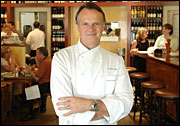
Frank Stitt, Highlands Bar & Grill, Birmingham, Ala., U.S.
Probably the most accomplished chef in the American South, Stitt honed his chops at Chez Panisse, and now transforms Alabama’s bounty into a refined fusion of southern U.S. and southern French.
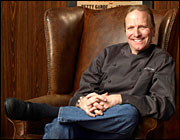
Michel Nischan, Dressing Room, Westport, Conn., U.S.
Newman’s own chef Nischan convinced the blue-eyed actor to turn his new restaurant into a high-profile temple to the produce of nearby farms.
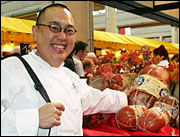
Tory Miller, L’Etoile, Madison, Wis., U.S.
Madison’s famed farmers’ market has no greater advertisement than the menu at L’Etoile, where Miller churns out French fare with a Midwestern accent.
Christine Kim, Green Zebra, Chicago, Ill., U.S.
In a neighborhood restaurant in Chicago, chef de cuisine Kim applies wildly inventive techniques to top-quality local produce, resulting in what might be the nation’s most dazzling vegetarian fare.
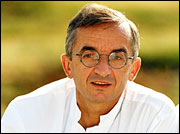
Michel Bras, Restaurant Bras, Laguiole, France
Considered one of the world’s most skilled chefs, Bras is also a quiet but fierce defender of biodiversity in France’s Aubrac region, from whose farms he’s said to use more than 300 kinds of vegetables.
Tom Philpott contributed to this list.

